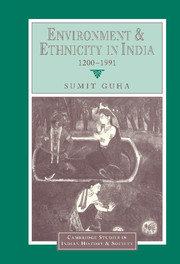Book contents
- Frontmatter
- Contents
- List of maps
- List of tables
- Acknowledgements
- Glossary
- List of abbreviations
- Introduction
- 1 From the archaeology of mind to the archaeology of matter
- 2 Subsistence and predation at the margins of cultivation
- 3 State formation in the highland forests 1350–1800
- 4 The peoples of the Sahyadri under Marathas and British
- 5 The central Indian forest from Mughal suzerainty to British control
- 6 The central Indian forest under early British rule
- 7 Identities and aspiration – not noble savage but savage noble
- 8 The high colonial period and after – new patterns of authority and power
- 9 From sanctuaries to safeguards: policies and politics in twentieth-century India
- Conclusion
- Afterword
- Bibliography
- Index
6 - The central Indian forest under early British rule
Published online by Cambridge University Press: 12 November 2009
- Frontmatter
- Contents
- List of maps
- List of tables
- Acknowledgements
- Glossary
- List of abbreviations
- Introduction
- 1 From the archaeology of mind to the archaeology of matter
- 2 Subsistence and predation at the margins of cultivation
- 3 State formation in the highland forests 1350–1800
- 4 The peoples of the Sahyadri under Marathas and British
- 5 The central Indian forest from Mughal suzerainty to British control
- 6 The central Indian forest under early British rule
- 7 Identities and aspiration – not noble savage but savage noble
- 8 The high colonial period and after – new patterns of authority and power
- 9 From sanctuaries to safeguards: policies and politics in twentieth-century India
- Conclusion
- Afterword
- Bibliography
- Index
Summary
Introduction
The previous chapter has already brought the narrative up to the commencement of direct British rule on the southern fringes of the Bhil country (annexed 1818), and indirect rule of the southern Gond lands (governed 1818–1830; annexed 1854). As we shall see, the new regime initially largely conformed to previous practice, and employed a mixture of bribery, force and intrigue to control the forest lands and their inhabitants. Chapter 5 noted that the crisis of the agrarian order had been relatively mild in the Nagpur region, and much severer in Khandesh. As a result, the efforts at settlement and resultant documentation are much more abundant for the latter, and it will figure prominently in this chapter. There was, none the less, a marked similarity in the historic trajectory of the two regions.
Both the ambitions and the capacities of the new government exceeded those of its predecessors, and these differences are discussed in the third section below. Its persistent pressure gradually destroyed both the natural and the political environment which had sustained the militant kingdoms at the margin of the sown: the processes whereby this was achieved are described in the fourth and fifth sections. These tides of change silently swamped the traditional order even in remote backwaters like the Dangs and Akhrani, and the last two sections of the chapter provide integrated histories of these regions from the eighteenth century to the late twentieth.
- Type
- Chapter
- Information
- Environment and Ethnicity in India, 1200–1991 , pp. 130 - 149Publisher: Cambridge University PressPrint publication year: 1999

